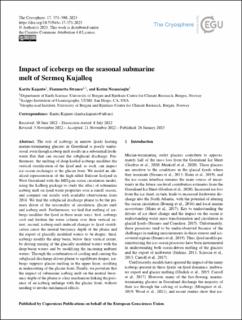| dc.description.abstract | The role of icebergs in narrow fjords hosting marine-terminating glaciers in Greenland is poorly understood, even though iceberg melt results in a substantial freshwater flux that can exceed the subglacial discharge. Furthermore, the melting of deep-keeled icebergs modifies the vertical stratification of the fjord and, as such, can impact ice–ocean exchanges at the glacier front. We model an idealised representation of the high-silled Ilulissat Icefjord in West Greenland with the MITgcm ocean circulation model, using the IceBerg package to study the effect of submarine iceberg melt on fjord water properties over a runoff season, and compare our results with available observations from 2014. We find the subglacial discharge plume to be the primary driver of the seasonality of circulation, glacier melt and iceberg melt. Furthermore, we find that melting of icebergs modifies the fjord in three main ways: first, icebergs cool and freshen the water column over their vertical extent; second, iceberg-melt-induced changes to fjord stratification cause the neutral buoyancy depth of the plume and the export of glacially modified waters to be deeper; third, icebergs modify the deep basin, below their vertical extent, by driving mixing of the glacially modified waters with the deep-basin waters and by modifying the incoming ambient waters. Through the combination of cooling and causing the subglacial-discharge-driven plume to equilibrate deeper, icebergs suppress glacier melting in the upper layer, resulting in undercutting of the glacier front. Finally, we postulate that the impact of submarine iceberg melt on the neutral buoyancy depth of the plume is a key mechanism linking the presence of an iceberg mélange with the glacier front, without needing to invoke mechanical effects. | en_US |

